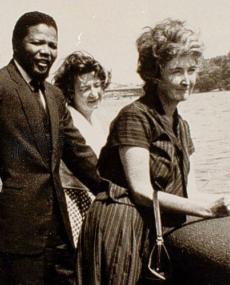
Freda Levson was born on 21 November 1911 in Pretoria, South Africa. Her father was a prominent physician in Johannesburg. She was educated in England from the age of 13, and studied geography at St Hugh's College in Oxford. She spent her holidays in Scotland throughout her school years and as a consequence developed a deep love of and interest in her Scottish roots.
At the outbreak of World War II she volunteered as an escort on a ship taking evacuee children to South Africa. In the early 1950s, she married the Russian emigrant photographer Leon Levson and they settled in Johannesburg. Freda ran her husband's photographic business from their home, which was also later used as a safe house for Nelson Mandela and other political activists.
Levson's involvement in liberation politics started in 1946 when she assisted the Reverend Michael Scott in his pioneering international campaign against South Africa. She took his dossier on the plight of the Namibians and his other campaign work and turned it into a powerful indictment. Levson and her husband were devoted supporters of Michael Scott, who first brought to the world’s conscience, through his petitioning at the UN in the late 1940s and 1950s, the Union of South Africa’s perversion of the ‘sacred trust’ of the League of Nations mandate for its rule of what was then South West Africa. When Scott left the United Nations in 1948, Levson put Scott’s paper together and published them as a book entitled In Face of Fear: Michael Scott’s Challenge to South Africa in London in 1950.
Her dedication in her first book was to all ‘displaced people’ in the world, of whom the Hereros, who had first sent Scott to the UN, were, with the Ovambos and Namas who joined in Scott’s petitioning the UN against incorporation into South Africa. It is signed at ‘Gammans River, South West Africa, 1950’, the dry river bed near the Old Location, Windhoek, where Michael Scott had pitched his tent when clandestinely taking evidence from the Hereros and others.
In 1952, Freda became involved in the launch of the African National Congress (ANC) and the South African Indian Congress's "defiance campaign against unjust laws". That same year Freda joined the protesters who entered the African location of Germiston without a permit during the campaign. Together with other activists, she was arrested and jailed for four weeks.
During the famous 1956 Treason Trial, 156 leaders and activists in the Congress Alliance were charged with high treason. Bishop Ambrose Reeves, Alan Paton, Alex Hepple, a Labour MP, Dr Ellen Hellman of the Institute of Race Relations and Julius First set up the South African Treason Trial Defence Fund which was later administered by Mary Benson, Freda Levson and Ruth Mompati. Freda Levson, was appointed its administrative secretary, and for four years the fund provided welfare and legal aid for those on trial and their families.
What then followed became one of the major forces that helped political prisoners and banned persons in South Africa. Through Canon John Collins, the International Defence and Aid Fund (IDAF) was established. IDAF channeled millions of pounds to assist activists, and thousands of victims of political persecutions, forced removals and banishments.
Through her work with IDAF, Freda forged close friendships with the leadership of the Congress Alliance in exile. In 1961 she handed over the administration of being secretary of IDAF to her close friend Mary Benson, the author. Her husband was ill, and they moved fleetingly to Malta in the hope of restoring his health. But he died in 1961 and she returned to London. It was there, in 1962, that Nelson Mandela visited her after leaving South Africa, illegally, to rally support. Levson also published Forbidden Pastures: Education under Apartheid (1967) and South Africa: An Historical Introduction in 1975.
While in exile, Levson maintained a lasting friendship with Mandela and was a supporter of both the Anti-Apartheid Movement and the Namibia Support Committee in London. Levson also served on the Council of the British Defence and Aid fund from 1980 to 1985. After the fall of apartheid Levson donated her papers to Fort Hare University in South Africa. Amongst the donated material were documents about Michael Scott whom she had rendered invaluable service in his great work for the Namibian people.
On her 90th birthday Levson received a telegram from Mandela in which he wrote that he would always remember her steadfast efforts during the Treason Trials and her courage and persistence over the years.
Freda Levson died on 7 October 2004 and is survived by two stepchildren.